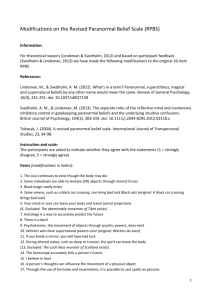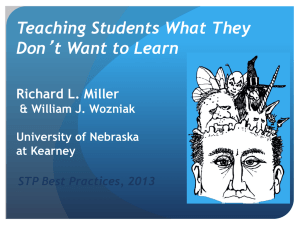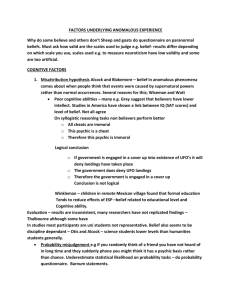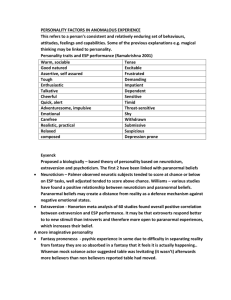Revised Paranormal Belief Scale: Development & Validation
advertisement
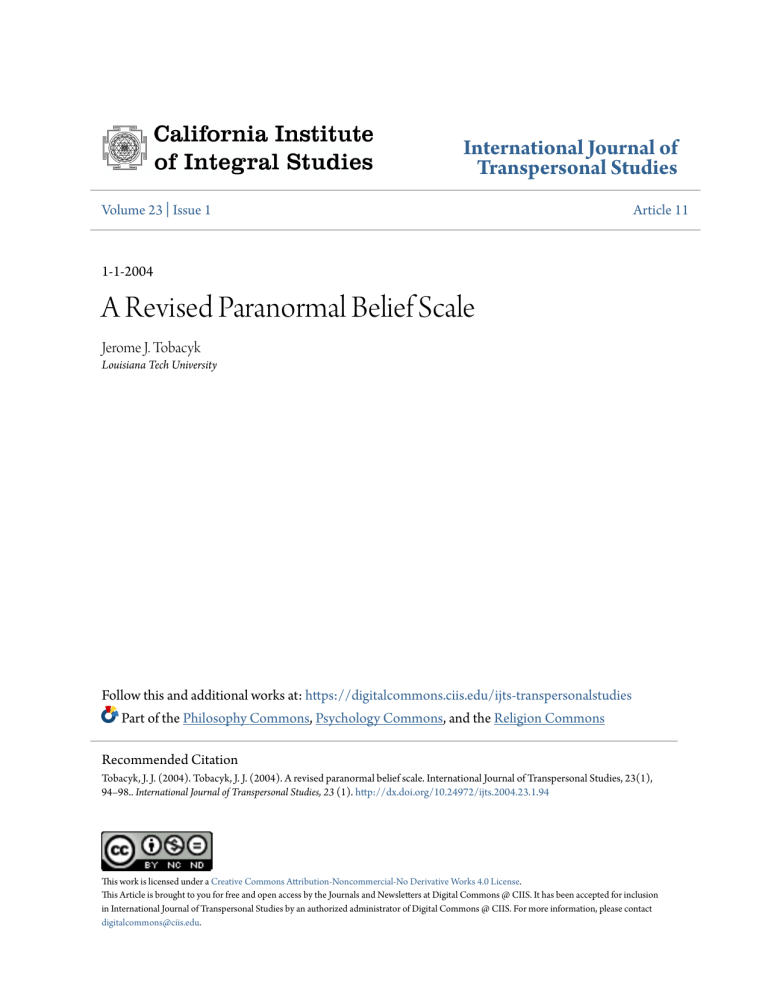
International Journal of Transpersonal Studies Volume 23 | Issue 1 Article 11 1-1-2004 A Revised Paranormal Belief Scale Jerome J. Tobacyk Louisiana Tech University Follow this and additional works at: https://digitalcommons.ciis.edu/ijts-transpersonalstudies Part of the Philosophy Commons, Psychology Commons, and the Religion Commons Recommended Citation Tobacyk, J. J. (2004). Tobacyk, J. J. (2004). A revised paranormal belief scale. International Journal of Transpersonal Studies, 23(1), 94–98.. International Journal of Transpersonal Studies, 23 (1). http://dx.doi.org/10.24972/ijts.2004.23.1.94 This work is licensed under a Creative Commons Attribution-Noncommercial-No Derivative Works 4.0 License. This Article is brought to you for free and open access by the Journals and Newsletters at Digital Commons @ CIIS. It has been accepted for inclusion in International Journal of Transpersonal Studies by an authorized administrator of Digital Commons @ CIIS. For more information, please contact digitalcommons@ciis.edu. A Revised Paranormal Belief Scale Jerome J. Tobacyk, Ph.D. Louisiana Tech University A 26-item Revised Paranormal Belief Scale is introduced which provides a measure of degree of belief in each of seven dimensions: Traditional Religious Belief, Psi, Witchcraft, Superstition, Spiritualism, Extraordinary Life Forms, and Precognition. Improvements from the original 25item Paranormal Belief Scale (Tobacyk & Milford, 1983) include adoption of a seven-point rating scale as well as item changes for three subscales: Precognition, Witchcraft, and Extraordinary Life Forms. These improvements provide greater reliability and validity, less restriction of range, and greater cross-cultural validity. major emphasis of current theory and research in transpersonal psychology is the investigation of spirituality—its nature, phenomenology, and assessment (MacDonald, 2000; MacDonald, Friedman, & Kuentzel, 1999; MacDonald, Kuentzel, & Friedman, 1999; MacDonald, LeClair, Holland, Alter, & Friedman, 1995). An essential requirement for the empirical investigation of spirituality is the articulation of the structure or dimensionality of this construct. MacDonald (2000) has reported a factor analytic investigation of the structure of spirituality that demonstrates five robust dimensions: Cognitive Orientation Toward Spirituality, Experiential/ Phenomenological Dimensions, Existential WellBeing, Religiousness, and Paranormal Beliefs. This article reports the development of a Revised Paranormal Belief Scale that can be used to assess paranormal and religious beliefs, allowing the researcher to examine the nature of these beliefs and their implications for spirituality. Considerable research concerning paranormal beliefs has employed the original Paranormal Belief Scale (PBS; Tobacyk & Milford, 1983), a measure of self-reported degree of belief in paranormal phenomena. Much evidence supports the reliability and discriminant validity of the PBS and its subscales (Tobacyk, 1983; Tobacyk, 1984a; 1984b; Tobacyk & Jones, 1984; Tobacyk & Milford, 1984; Tobacyk, 1985a; Tobacyk, 1985b; Tobacyk & Mitchell, 1987a; A 94 1987b; Tobacyk, Nagot, & Miller, 1987). Paranormal phenomena are defined as those that, if genuine, would violate basic limiting principles of science (Broad, 1953). An example of a basic limiting principle is It is unlikely that a mental event can directly affect a physical event except for one in the experient’s own brain. Thus, psychosomatic and hypnotically induced phenomena are not classified as paranormal, but psychokinetic phenomena, if authentic, would be so classified. The PBS provides a separate score on each of seven factorially derived subscales, with each subscale reflecting a major dimension of paranormal belief. The PBS subscales are Traditional Religious Belief, Psi, Witchcraft, Superstition, Spiritualism, Extraordinary Life Forms, and Precognition. Respondents indicate degree of belief for each of 25 items by using a fivepoint rating scale. Although the original PBS shows satisfactory reliability and validity, a Revised Paranormal Belief Scale (R-PBS) has been constructed with changes in the rating scale and in item content for three subscales. More specifically, these changes involve (1) use of a sevenpoint rating scale, (2) construction of a new Precognition subscale, (3) replacement of two of four Witchcraft subscale items, and (4) replacement of one of three Extraordinary Life Forms subscale items. These changes were made to lessen restriction in range and to improve subscale reliability and validity, partic- The International Journal of Transpersonal Studies, 2004, Volume 23 ularly cross-cultural validity. Seven-Point Rating Scale Some restriction in range occurred on the original PBS, particularly on the Traditional Religious Belief and Superstition subscales. To reduce restriction in range, a seven-point rating scale is used with the RPBS. Table 1 lists the means, standard deviations, and maximum and minimum scores for both the original PBS and the R-PBS. As indicated in Table 1, the minimum and maximum mean item scores for each of the R-PBS subscales suggest that respondents generally use the full seven-point rating scale. Also, as indicated in Table 1, the standard deviations have approximately doubled for four subscales: Traditional Religious Belief, Psi, Witchcraft, and Spiritualism. A seven-point rating scale allows respondents to more precisely describe their beliefs, and will lessen restriction of range. Precognition Subscale The original Precognition subscale had the lowest test-retest reliability of the seven original PBS subscales (rtt = .60 over a four-week interval). The three PBS Precognition subscale items are as follows: Item 1 – Dreams can provide information about the future; Item 2 – Some people have the ability to predict the future; and Item 3 – The idea of predicting the future is foolish. Each of the PBS Precognition subscale items is ambiguous and could be endorsed for reasons that do or do not reflect belief in paranormal precognition. For example, regarding Item 1, a dream could provide accurate information about the future simply owing to coincidence or through normal cognitive processes (e.g., “remembering” the location of a lost object in a dream). Thus, endorsement of Item 1 Table 1 A Comparison of Norms on the Original and Revised Paranormal Belief for University Students in the Southern United States _____________________________________________________________________________ Original Paranormal Revised Paranormal Belief Scale Belief Scale PBS Score (n=460) (n=217) _______________________________________________________________________ M SD Min Max M SD Min Max ______________________ _______________________ Full Scale 72.9 11.1 41 104 89.1 21.9 40 165 Traditional Religious Belief 4.5 0.6 1.0 5.0 6.3 1.2 1.0 7.0 Psi 2.8 0.7 1.0 5.0 3.1 1.5 1.0 7.0 Witchcraft 2.5 0.8 1.0 5.0 3.4 1.7 1.0 7.0 Superstition 1.7 0.7 1.0 4.0 1.6 1.2 1.0 5.0 Spiritualism Extraordinary Life Forms 2.4 0.7 1.0 5.0 2.8 1.4 1.0 7.0 2.4 0.8 1.0 5.0 3.3 1.3 1.0 7.0 Subscales Precognition 3.5 0.7 1.0 5.0 3.0 1.3 1.0 7.0 ________________________________________________________________________ Note. Mean scores refer to sum of item scores for Full Scale and mean item scores for subscales. Paranormal Belief Scale 95 might or might not reflect belief in paranormal precognition. Concerning Item 2, trained scientists (e.g., meteorologists, medical diagnosticians) use scientifically validated procedures to predict future events. Thus, endorsement of Item 2 might reflect either belief in paranormal precognition or belief in the accu- racy of predictions made by such scientifically validated prognosticators as medical diagnosticians or meteorologists. Item 3 is also ambiguous in meaning. For example, are all human attempts at predicting the future foolish, including saving for retirement or purchasing insurance policies? Alternatively, Item 3 might Table 2 Revised Paranormal Belief Scale ___________________________________________________________________________________ Please put a number next to each item to indicate how much you agree or disagree with that item. Use the numbers as indicated below. There are no right or wrong answers. This is a sample of your own beliefs and attitudes. Thank you. 1=Strongly Disagree 2=Moderately Disagree 3=Slightly Disagree 4=Uncertain 5=Slightly Agree 6=Moderately Agree 7=Strongly Agree 1. The soul continues to exist though the body may die. 2. Some individuals are able to levitate (lift) objects through mental forces. 3. Black magic really exists. 4. Black cats can bring bad luck. 5. Your mind or soul can leave your body and travel (astral projection). 6. The abominable snowman of Tibet exists. 7. Astrology is a way to accurately predict the future. 8. There is a devil. 9. Psychokinesis, the movement of objects through psychic powers, does exist. 10. Witches do exist. 11. If you break a mirror, you will have bad luck. 12. During altered states, such as sleep or trances, the spirit can leave the body. 13. The Loch Ness monster of Scotland exists. 14. The horoscope accurately tells a person’s future. 15. I believe in God 16. A person’s thoughts can influence the movement of a physical object. 17. Through the use of formulas and incantations, it is possible to cast spells on persons. 18. The number “13” is unlucky. 19. Reincarnation does occur. 20. There is life on other planets. 21. Some psychics can accurately predict the future. 22. There is a heaven and a hell. 23. Mind reading is not possible. 24. There are actual cases of witchcraft. 25. It is possible to communicate with the dead. 26. Some people have an unexplained ability to predict the future. ___________________________________________________________________________________ Note. Item 23 is reverse scored. Traditional Religious Belief = Mean of Items (1, 8, 15, 22); Psi = Mean of Items (2, 9, 16, 23); Witchcraft = Mean of Items (3, 10, 17, 24); Superstition = Mean of Items (4, 11, 18); Spiritualism = Mean of Items (5, 12, 19, 25) Extraordinary Life Forms = Mean of Items (6, 13, 20); Precognition = Mean of Items (7, 14, 21, 26). 96 The International Journal of Transpersonal Studies, 2004, Volume 23 be construed as meaning that only paranormal methods of predicting the future are foolish. Thus all three items comprising the Precognition subscale on the original PBS are problematic. In a study of the cognitive dimensions used in predicting future events (Tobacyk & Nagot, 1987), 349 college students rated 60 beliefs about predicting future events. The 60 items were intercorrelated and factor analyzed, revealing seven basic dimensions used to predict future events. The two clearest marker items were selected from each of the two largest paranormal precognition dimensions to form a new Precognition subscale. These dimensions and items were Paranormal Divinatory Systems (Astrology is a way to accurately predict the future. The horoscope accurately tells a person’s future.) and Psychically Gifted Persons (Some psychics can accurately predict the future. Some people have an unexplained ability to predict the future.). These four new Precognition items replaced the three original PBS Precognition items. The test-retest reliability of this revised Precognition subscale over a fourweek interval was .81, a substantial improvement over the reliability of the original PBS Precognition subscale (rtt = .60). Witchcraft and Extraordinary Life Forms Subscales Changes were made in the Witchcraft and Extraordinary Life Forms subscales to improve crosscultural validity in Western cultures. Research with the original PBS in Finland, Germany, and Poland, showed that many European respondents were unfamiliar with such ostensibly paranormal phenomena as voodoo and Bigfoot. Therefore, on the Witchcraft subscale, the two items concerning belief in voodoo (Voodoo is a real method to use paranormal powers. There are actual cases of voodoo death.) were replaced with two items that more generally concerned witchcraft (Through the use of formulas and incantations, it is possible to cast spells on persons. There are actual cases of witchcraft.) It is noted that the two replacement Witchcraft subscale items were marker variables defining the Witchcraft factor in the original factor analytic PBS study (Tobacyk & Milford, 1983), loading .68 and .55 respectively on the Witchcraft factor. The testretest reliability of the revised Witchcraft subscale is .93 over a four-week interval, while that of the original Witchcraft subscale is .69. Also, to improve cross-cultural validity, the item Bigfoot does exist from the original Extraordinary Life Forms subscale was replaced by the item There is life on other planets. Although the item Bigfoot does exist had a stronger factor loading than the replacement item in the original factor analytic study (.74 versus .41), the new item was also a marker variable for the Extraordinary Life Forms factor. This change was necessary because familiarity with the Bigfoot phenomena appears largely limited to the United States. The revised Extraordinary Life Forms subscale has a fourweek test-retest reliability of .91, compared to .82 for the original subscale. It is noted that Extraordinary Life Forms is the only paranormal belief dimension that does not strictly conform to the paranormality criterion violation of a basic limiting principle of science (e.g., the mere existence of extraterrestrial life would not violate a basic limiting principle). However, belief in extraordinary life forms is often considered a component of a more general paranormal or occult ideology (Zusne & Jones, 1982) and was therefore included as a paranormal belief dimension. Revised Paranormal Belief Scale Items The remaining 18 items from the original PBS were retained in the R-PBS. The four-week test-retest reliabilities for the remaining R-PBS subscales for a sample of forty university students are as follows: Full Scale .92, Traditional Religious Belief .95, Psi .71, Superstition .89, and Spiritualism .91. Validity Issues Although there has been some disagreement about the nature and number of the belief dimensions assessed by the R-PBS (Lawrence, 1995a, 1995b, Lawrence, Roe, & Williams, 1997; Tobacyk, 1995a, Tobacyk, 1995b, Tobacyk & Thomas, 1997), this scale appears to be a conceptually and psychometrically satisfactory measure of paranormal beliefs. Summary The original 25-item, five-point PBS was modified into a 26-item, seven-point R-PBS. The changes include replacement of the three-item PBS Precognition subscale, replacement of two of the four PBS Witchcraft subscale items, and replacement of one of the three PBS Extraordinary Life Forms subscale items. In total, seven new items replaced a total of six original PBS items. These changes are expected Paranormal Belief Scale 97 to improve reliability and validity, reduce restrictions in range, and increase the cross-cultural validity in the measurement of paranormal beliefs in Western cultures. It is recommended that researchers in the areas of paranormal beliefs and spirituality consider the use of the R-PBS in their investigations. References Broad, C. D. (1953). The relevance of psychical research to philosophy. In J. Ludwig (Ed.), Philosophy and parapsychology (pp. 43- 63). Buffalo, NY: Prometheus. Lawrence, T. (1995a). How many factors of paranormal belief are there?: A critique of the PBS. Journal of Parapsychology, 59, 3 – 25. Lawrence, T. (1995b). Moving on from the PBS: A final reply to Tobacyk. Journal of Parapsychology, 59, 131-140. Lawrence, T., Roe, C., & Williams, C. (1997). Confirming the factor structure of the Paranormal Beliefs Scale: Big orthogonal seven or oblique five? Journal of Parapsychology, 61, 13-31. MacDonald, D. A. (2000). Spirituality: Description, measurement and relation to the five factor model of personality. Journal of Personality, 68(1), 153-197. MacDonald, D. A., Friedman, H. L., & Kuentzel, J. G. (1999). A survey of measures of spiritual and transpersonal constructs: Part one—Research update. Journal of Transpersonal Psychology, 31(2), 137-154. MacDonald, D. A., Kuentzel, J. G., & Friedman, H. L. (1999). A survey of measures of spiritual and transpersonal constructs: Part two—Additional instruments. Journal of Transpersonal Psychology, 31(2), 155-177. MacDonald, D. A., LeClair, L., Holland, C. J., Alter, A., & Friedman, H. L. (1995). A survey of measures of transpersonal constructs. Journal of Transpersonal Psychology, 27(2), 171-235. Tobacyk, J. (1983). Paranormal beliefs, interpersonal trust and social interest. Psychological Reports, 53, 229-230. Tobacyk, J. (1984a). Death threat, death concerns and paranormal belief. In F. R. Epting & R. A. Neimeyer (Eds.), Personal meanings of death (pp. 29-38). New York: Hemisphere. Tobacyk, J. (1984b). Paranormal belief and college grade point average. Psychological Reports, 54, 98 217–218. Tobacyk, J. (1985a). Paranormal beliefs, alienation, and anomie in college students. Psychological Reports, 57, 844–846. Tobacyk, J. (1985b). The paranormal belief scale and social desirability. Psychological Reports, 57, 624. Tobacyk, J. (1995a). What is the correct dimensionality of paranormal beliefs?: A reply to Lawrence’s critique of the Paranormal Belief Scale. Journal of Parapsychology, 59, 27–46. Tobacyk, J. (1995b). Final thoughts on issues in the measurement of paranormal beliefs. Journal of Parapsychology, 59, 141–145. Tobacyk, J., & Jones, G. (1984). Paranormal beliefs of high school students. Psychological Reports, 55, 255261. Tobacyk, J., & Milford, G. (1983). Belief in paranormal phenomena: Assessment instrument development and implications for personality functioning. Journal of Personality and Social Psychology, 44, 648–655. Tobacyk, J., & Milford, G. (1984). Superstition and intentionality. Psychological Reports, 55, 513-514. Tobacyk, J., & Mitchell, T. (1987a). Out-of-body experience status as a moderator of effects of narcissism on paranormal beliefs. Psychological Reports, 60, 440-442. Tobacyk, J., & Mitchell, T. (1987b). The out-of-body experience and personality adjustment. Journal of Nervous and Mental Disease, 175(6), 367-370. Tobacyk, J., Nagot, E., & Miller, M. (1987). Paranormal beliefs and locus of control: A multidimensional examination. Journal of Personality Assessment, 52(2), 241-246. Tobacyk, J., & Thomas, A. (1997). How the big orthogonal seven is really the oblique seven. Journal of Parapsychology, 61, 337-342. Zusne, L., & Jones, W. H. (1982). Anomalistic psychology. Hillsdale, N. J.: Erlbaum. Correspondence regarding this article should be directed to the author at the following address: Louisiana Tech University, Department of Psychology and Behavioral Sciences, Box 10048, Ruston, Louisiana 71272. e-mail: Jerryt@vm.cc.latech.edu The International Journal of Transpersonal Studies, 2004, Volume 23
